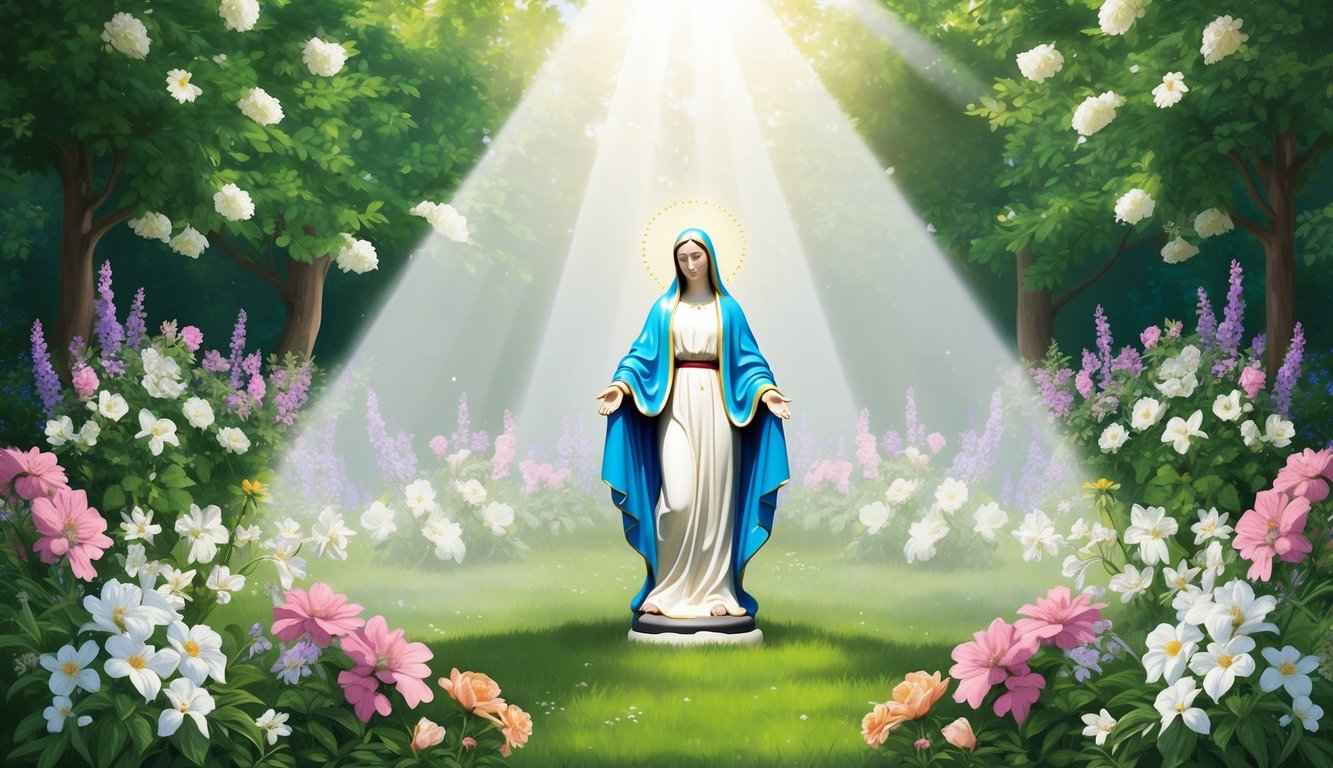Don’t Miss Out On This Unique Astrological Opportunity
Are you tired of spinning your wheels and getting nowhere? Simply put, you’re out of sync: you’re out of alignment with your astral configuration.
But: there’s a kind of map that can help you reclaim your alignment. Think of it as your own personal blueprint to success and happiness: a blueprint that will help you live your most amazing life.
Get started here.
The Virgin Mary Prayer has been a central part of Christian spirituality for centuries, offering followers a means to express their faith and devotion. These prayers are a way to seek guidance, comfort, and intercession from Mary. This connection has been enhanced by the widespread practice of the “Hail Mary” and the Hours of the Virgin.
In many cultures, the Virgin Mary is revered for her role as a comforting mother figure.
This is why the rituals and prayers dedicated to her often include contemplative and petitionary elements, drawing believers into a deeper faith experience.
Visual symbols like flowers in a garden have long been associated with Marian prayers, representing purity and grace, as seen in historical practices.
From daily personal devotions to grand feast days, prayers to the Virgin Mary provide a structured yet deeply personal way for you to connect with your faith.
Whether you’re seeking peace in troubled times or thanking divine intercession, these prayers offer a timeless spiritual anchor.
Key Takeaways
- Prayers to the Virgin Mary offer guidance and comfort.
- Marian prayers combine both structured and personal elements.
- Devotion to Mary is expressed in personal and communal practices.
Origins and Significance
Prayer involving the Virgin Mary holds a prominent place in religious traditions.
It roots back deeply into the cultural and theological fabric of Christianity, especially within the Catholic Church.
Its historical growth mirrors its spiritual importance, affecting various faith practices.
Historical Background
The practice of praying to the Virgin Mary finds its origins in early Christianity.
As the Mother of God, she emerged as a prominent figure in the nascent Church.
Mary was viewed as a compassionate intercessor, someone who could mediate between humans and the divine.
Over centuries, this belief became deeply woven into Catholic traditions.
The role of Mary in prayer expanded during medieval times, when she was depicted with reverence in art and literature.
Church leaders encouraged devotion to Mary, seeing it as a pathway to deepen faith and spirituality.
Theological Importance
Theologically, praying to the Virgin Mary is crucial for many believers.
In Catholic doctrine, Mary holds the title of Theotokos, or God-bearer, affirming her central role in the mystery of salvation.
Her willingness to embrace God’s plan is viewed as an example of ultimate faith and obedience.
Prayer involving Mary often seeks her intercession, asking for her to pray on behalf of the faithful.
This is based on the belief that her close connection to Jesus grants her a special place in divine matters.
The Hail Mary is one of the most well-known prayers, reflecting her importance in bridging the human and holy.
Roles in Various Traditions
Mary’s role in prayer varies across different Christian traditions.
In the Catholic Church, she is honored with numerous feasts and devotions, such as the Rosary, which is a series of prayers reflecting on key events in her life and that of Jesus.
Orthodox Christians also hold her in high regard, viewing her as a protective figure.
She is often depicted in Byzantine art and worship.
Other Christian denominations may view her differently, focusing less on direct prayer to her but still recognizing her as a vital figure in the story of faith.
Each tradition, however, sees her as an embodiment of humility and divine love.
Core Prayers to Mary
The prayers to the Blessed Virgin Mary are central to many Christians’ spiritual lives.
They seek Mary’s intercession, guidance, and protection.
These prayers express themes of grace, mercy, and hope and are steeped in tradition.
Hail Mary
The Hail Mary is a foundational prayer in the Catholic tradition.
It begins with the words spoken by the angel Gabriel, “Hail Mary, full of grace, the Lord is with thee.” This highlights Mary’s special role and grace.
The second part of the prayer asks for Mary’s intercession, emphasizing hope and love: “Holy Mary, Mother of God, pray for us sinners, now and at the hour of our death.” These words offer reassurance and a plea for support.
The Angelus
The Angelus is traditionally recited three times a day: morning, noon, and evening.
This prayer commemorates the Annunciation, when Gabriel announced to Mary that she would be the Mother of God.
Each part of the Angelus highlights Mary’s role in the Incarnation.
The response, “Be it done unto me according to Thy word,” underscores her acceptance and willingness to fulfill God’s will.
The Angelus serves as a reminder of faith and devotion.
Hail Holy Queen
The Hail Holy Queen is a prayer of praise and petition.
Often concluding the rosary, it addresses Mary as “Queen of Mercy,” expressing trust in her compassion.
The prayer asks her to “turn thine eyes of mercy toward us” and confidently requests her aid.
Themes of intercession and hope are central, as believers recount their struggles and seek comfort from Mary.
The prayer ends with a call for her loving guidance.
The Hail Holy Queen Prayer remains a cherished devotion among Catholics, reinforcing their faith in Mary’s compassionate intercession.
By invoking her aid, believers find solace in her unwavering support during times of difficulty.
This prayer serves as a reminder of Mary’s motherly care, inspiring trust and devotion in those who seek her guidance.
Memorare
The Memorare is a prayer that encourages you to seek Mary’s help in times of need.
With the phrase, “Remember, O most gracious Virgin Mary, that never was it known that anyone who fled to thy protection, implored thy help, or sought thy intercession, was left unaided,” it underscores the trust and confidence in her mercy.
This prayer reflects strong faith in Mary’s willingness to assist those in distress, emphasizing hope and love.
Magnificat
The Magnificat is a song of praise that Mary sang during her visit to Elizabeth.
Found in the Gospel of Luke, it begins with “My soul magnifies the Lord, and my spirit rejoices in God my Savior,” expressing joy and gratitude.
This prayer reflects on God’s greatness and mercy, acknowledging His power and the blessings granted to Mary.
The Magnificat is a deep expression of faith and trust in God’s plan.
Contemplative and Petitionary Prayers

In the realm of prayer, both contemplative and petitionary forms serve unique roles.
Contemplative prayers often help you seek a deeper connection with the divine, while petitionary prayers allow you to request aid and protection.
Intercessory Role of Mary
The Virgin Mary plays a significant role in intercessory prayers.
As the Mother of Jesus Christ, many believe she can intercede on your behalf, pleading for mercy and compassion.
Often referred to as the Comforter of the Afflicted, Catholics turn to Mary for hope and guidance in times of danger or despair.
Such prayers typically ask Mary to present your petitions to God, believing that her purity and closeness to Christ give her requests special weight.
This belief is rooted in the idea that Mary’s intercession can help bring protection and relief from earthly troubles.
Petitions for Help and Protection
Petitionary prayers often involve asking for specific favors or aid, including protection from harm or for health and peace in your life.
In these prayers, you might call upon Mary’s assistance to shield you from danger or provide strength through life’s challenges.
Many appeal to her during moments of despair, trusting that her compassion and understanding will lead to divine intervention.
Repeated phrases like “Amen” affirm your faith and trust in Mary’s ability to deliver your petitions to Jesus Christ.
Whether you’re seeking comfort in times of grief or pleading for safety, these prayers emphasize the belief in God’s power to change circumstances on Earth and provide spiritual comfort.
Devotional Practices and Feasts

Devotional practices dedicated to the Virgin Mary play an important role in Catholic traditions.
They often include prayers and celebrations that honor her as the Mother of God and Queen of Heaven, using tools like the Rosary and iconic imagery to deepen one’s faith and connection.
Monthly Dedications and Feast Days
Each month often highlights specific devotions to honor the Virgin Mary.
For example, May is traditionally dedicated to her, with special activities and prayers like the crowning of Mary, acknowledging her as the Queen of Heaven.
Significant feast days include the Feast of Our Lady of Lourdes, celebrated on February 11, recognizing her miraculous apparitions in France.
The Feast of the Immaculate Conception, observed on December 8, commemorates the doctrine that she was conceived without original sin.
These celebrations often involve communal prayer services and joyous gatherings, enhancing your spiritual connection and understanding of Mary’s significant role in faith.
Devotional Tools and Icons
Devotion to the Virgin Mary is often expressed through various tools and icons that facilitate deeper engagement.
The Rosary, a string of beads used in prayer, is a prominent tool, guiding you through prayers like the Salve Regina and Regina Coeli.
Both of these are well-known Marian hymns that celebrate Mary’s role in bringing joy and hope.
Icons, such as the Miraculous Medal, serve as powerful symbols in your daily devotions.
This medal is believed to offer special graces to those who wear it with faith.
These tools and icons support your journey in building a strong devotional life, connecting you with Mary’s compassionate intercession.
Frequently Asked Questions

This section covers various prayers associated with the Virgin Mary, highlighting different types of prayer used in Catholic devotion.
You will find insights on prayers for protection, healing, and honoring Mary.
What is the most powerful Catholic prayer?
The Rosary is often considered one of the most powerful Catholic prayers.
Devotees believe it brings peace and helps them meditate on the life of Jesus and the role of Mary.
Reciting the Rosary involves repeating prayers like the Hail Mary, Our Father, and Glory Be.
What is a short prayer to honor the Virgin Mary?
A well-known short prayer to honor Mary is the Hail Mary.
This prayer addresses Mary as full of grace and blessed among women, asking her to pray for sinners now and at the hour of death.
Which prayer is considered the protection prayer from Mother Mary?
The Memorare is often seen as a prayer for protection from Mother Mary.
It seeks her help and mercy, trusting in her intercession to provide safety and strength during difficult times.
What prayer can I say for a miracle from Mother Mary?
For those seeking miracles, the Novena to Our Lady of the Miraculous Medal can be significant.
This prayer requests Mary’s intervention for specific intentions and is often said over nine consecutive days.
Many believe in its power to bring profound changes or miracles.
How is the Hail Holy Queen prayer used in devotion to Mary?
The Hail Holy Queen, or Salve Regina, is a traditional prayer recited at the end of the Rosary.
It addresses Mary as a compassionate figure and asks for her aid and comfort, reinforcing her role as a loving mother in Catholic faith.
What was Mary’s prayer in the Bible?
Mary’s prayer in the Bible is the Magnificat, found in the Gospel of Luke.
It reflects her praise and gratitude to God, celebrating His power and mercy.
This prayer is an expression of Mary’s humility and faith.
It is often recited during the Liturgy of the Hours in the Catholic Church.



